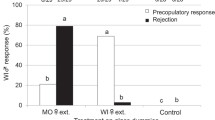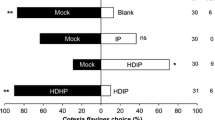Abstract
Volatile chemicals from Citrus and Salix host plants evoke orientation behavior in males of the species Anoplophora malasiaca (Thomson) (Coleoptera: Cerambycidae). These chemicals are emitted from wounded branches. We hypothesized that when released, these chemicals may indicate the presence of an individual to other conspecifics. Insects that originate from different host plants may use different plant chemicals from their own host to communicate with conspecifics. To further explore this theory, we investigated this communication system in a population of A. malasiaca from a third host plant, blueberry (Vaccinium spp.). Males from a blueberry host (Vaccinium population) were attracted to the odor of wounded Vaccinium branches when released near a female model in the laboratory, as has been observed in males found on Citrus and Salix host plants. The Vaccinium branch extract that was attractive to the males was separated into six fractions, of which two were active. Three active compounds were subsequently identified: β-caryophyllene and sulfur from the hexane fraction, and (E)-phytol in the weakly polar fraction. The latter two active compounds of Vaccinium branches were different from those found in Citrus and Salix.










Similar content being viewed by others
References
Adachi I (1988) Reproductive biology of the white-spotted longicorn beetle, Anoplophora malasiaca Thomson (Coleoptera: Cerambycidae), in citrus trees. Appl Entomol Zool 23:256–264
Fukaya M, Akino T, Yasuda T, Tatsuki S, Wakamura S (1999) Mating sequence and evidence for synergistic component in female contact sex pheromone of the white-spotted longicorn beetle, Anoplophora malasiaca (Thomson) (Coleoptera: Cerambycidae). Entomol Sci 2:183–187
Fukaya M, Akino T, Yasuda T, Yasui H, Wakamura S (2004) Visual and olfactory cues for mate orientation behaviour in male white-spotted longicorn beetle, Anoplophora malasiaca. Entomol Exp Appl 111:111–115
Ohbayashi N (1992) Genus Anoplophora Hope, 1839. In: Ohbayashi N, Satô M, Kojima K (eds) An illustrated guide to identification of longicorn beetles of Japan. Tokai University Press, Tokyo, pp 583–584 (in Japanese)
Phelan PL, Silk PJ, Northcott CJ, Tan SH, Baker TC (1986) Chemical identification and behavioral characterization of male wing pheromone of Ephestia elutella (Pyralidae). J Chem Ecol 12:135–146
Sokal RR, Rohlf FJ (1995) Biometry, the principles and practice of statistics in biological research, 3rd edn. WH Freeman and Co., New York, p 887
Vencl FV, Morton TC (1998) The shield defense of the sumac flea beetle, Blepharida rhois (Chrysomelidae: Alticinae). Chemoecology 8:25–32
Yasuda T (1997) Chemical cues from Spodoptera litura larvae elicit prey-locating behavior by the predatory stink bug, Eocanthcona furcellata. Entomol Exp Appl 82:349–354
Yasui H, Yasuda T, Fukaya M, Akino T, Wakamura S, Hirai Y, Kawasaki K, Ono H, Narahara M, Kousa K, Fukuda T (2007) Host plant chemicals serve intraspecific communication in the white-spotted longicorn beetle, Anoplophora malasiaca (Thomson) (Coleoptera: Cerambycidae). Appl Entomol Zool 42:255–268
Yasui H, Akino T, Fukaya M, Wakamura S, Ono H (2008) Sesquiterpene hydrocarbons: kairomones with a releaser effect in the sexual communication of the white-spotted longicorn beetle, Anoplophora malasiaca (Thomson) (Coleoptera: Cerambycidae). Chemoecology 18:233–242
Yasui H (2009) Chemical communication in mate location and recognition in the white-spotted longicorn beetle, Anoplophora malasiaca (Coleoptera: Cerambycidae). Appl Entomol Zool 44:183–194
Yasui H, Fujiwara-Tsujii N, Wakamura S (2011) Volatile attractant phytochemicals for a population of white-spotted longicorn beetles Anoplophora malasiaca (Thomson) (Coleoptera: Cerambycidae) fed on willow differ from attractants for a population fed on citrus. Chemoecology 21:51–58
Acknowledgments
Special thanks are due to the students, parents, and teachers of the Ooshika Elementary School for collecting A. malasiaca beetles in the blueberry gardens. We thank Sadayasu Yanagishima of Ooshika Village, Sumie Shimizu and Kazuyo Taguchi of NIAS for providing the Vaccinium branches, and Tetsuya Yasuda of NARC for providing pure (E)-phytol. Thanks are also due to Seiji Tanaka, Koutaro Maeno, and Ken-ichi Harano of NIAS for invaluable discussions and critical comments. We also appreciate the improvements made to the manuscript by Serge Glushkoff.
Author information
Authors and Affiliations
Corresponding author
Rights and permissions
About this article
Cite this article
Fujiwara-Tsujii, N., Yasui, H., Wakamura, S. et al. The white-spotted longicorn beetle, Anoplophora malasiaca (Coleoptera: Cerambycidae), with a blueberry as host plant, utilizes host chemicals for male orientation. Appl Entomol Zool 47, 103–110 (2012). https://doi.org/10.1007/s13355-012-0095-9
Received:
Accepted:
Published:
Issue Date:
DOI: https://doi.org/10.1007/s13355-012-0095-9




